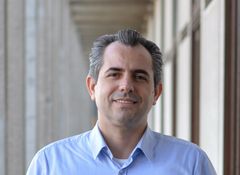Researchers: "We have miscalculated for decades – half of an insulin dose may not work as expected"

If you are one of the many millions of type 1 diabetics worldwide, you know that there is a difference in how rapidly and for how long insulin preparations work in the body. For diabetics, these differences are crucial for effective treatment. Getting too little or too much insulin can lead to blood sugar that is either too low or high. Both conditions can be dangerous.
The absorption of insulin in the body is controlled by how insulin molecules assemble themselves in clusters. Whereas a single molecule provides rapid action in the body, clusters of six molecules – known as hexamers – are long-acting. For decades, it has been assumed that insulin assembles with a certain distribution of molecular clusters of either one, two or six molecules. Pharmaceuticals have been designed based upon this assumption.
But with the help of highly advanced single molecule microscopy, researchers at the University of Copenhagen, in collaboration with Aarhus University, have become the first to demonstrate that this important point has been wrong for years.
"It is now apparent to us that we’ve gotten things wrong by 200 percent. There are only half as many single molecules in insulin compared to what we thought. Conversely, there are far more six-molecule clusters than we assumed. These experiments were not on animals but were performed on a microscope slide and one should be careful how to interpret their direct application to humans," says Professor Nikos Hatzakis of the Department of Chemistry, the study’s lead author.
He adds:
"However, our results may mean that when we believe to be administering a certain dose, it may mean that insulin behaves in a different way than expected and that even better insulin therapeutics can be developed.”
In other words, much of the insulin that diabetics currently put into their bodies may not actually be getting absorbed as expected. While the researchers emphasize that this is not outright dangerous for patients, it does show that there is great potential for the development of more precise medications.
The study, Enhanced Hexamerization of Insulin via Assembly Pathway Rerouting Revealed by Single Particle Studies, has been published in the scientific journal Communications Biology.
From a crude model to detailed view
"Insulin preparations have only gotten better and better over the years, and a great many diabetics are well regulated. However, the development of insulin preparations has been based on a certain assumption about how the molecules assemble. With the crude standard model, this process was never been appreciated at a detailed level. That's what we can do," says the study’s other lead author, Professor Knud J. Jensen, of the Department of Chemistry.
"This doesn’t mean that current insulin medications are bad or that patients have been medicated wrongly. But we now have a basic understanding of how insulin behaves and how much could be available to the body as rapid-acting medication. We now have the right method for providing us with accurate figures. We hope that the industry will use this or a similar tool – both to check current insulin preparations and to develop new ones," adds Nikos Hatzakis.
The research results were achieved through a mix of chemistry, machine learning, simulations and advanced microscopy. The Department of Chemistry researchers began by directly observing the process in which each insulin molecule joins forces with other molecules to assemble into clusters. This allowed them to see how fast each cluster forms. The researchers looked at about 50,000 clusters.
Knowing the exact distribution of different clusters in a given amount of insulin is fundamental when developing medications that need to have either short- or long-acting effects in the body:
"The clustering of insulin is incredibly important for how preparations work. Because the difference between a rapid- and slow-acting insulin preparation is dependent upon how quickly the molecules assemble in clusters and how quickly they disassemble. Access to highly advanced equipment makes it relatively simple and fast to gain insight into exact concentrations, knowledge that at the same time, is also quite sophisticated," says lead author Freja Bohr, a Ph.D. fellow in Nikos Hatzakis’ research group at the Department of Chemistry.
Better insulin benefits millions
In addition to the different distribution of molecular clusters, the observations also show that cluster formation is a much more complex process than once presumed. The clusters can both grow and shrink at far more different intervals than previously supposed.
"Without being able to say exactly how just yet, this should make it possible to expand the number of ways in which preparations are designed. This could lead to an insulin with a different effect profile that reduces the fluctuations in patients' blood sugar – which remains a major challenge," says Freja Bohr.
Knud J. Jensen, who has been researching insulin for more than 15 years, believes that the new knowledge will be able to optimize all types of new insulin and make a difference for the more than 40 million children and adults who take insulin on a daily basis. Life as a diabetic is still not without trouble:
"I sometimes receive inquiries from parents who ask if there is something better for treating their young children. When a person has poorly regulated type 1 diabetes, they can feel awful for long periods of time. Among other things, they can wake up with nightmares, feel unwell due to low or high blood sugar concentrations, risk losing consciousness due to low blood sugar and suffer consequential damage to their eyes and feet later on in life. So, if life can be made better for children by making better insulin, that's fantastic!" says Jensen.
FACT BOX: DIABETES AND INSULIN
- Insulin is a hormone produced in the pancreas that regulates the amount of sugar in blood. Diabetes sufferers have immune systems that destroy the insulin producing cells in the pancreas. Type 1 diabetics rely on insulin injections.
- Individual insulin molecules (monomers) are often assembled in clusters of two (dimer), or six (hexamer) individual molecules. Insulin is produced and stored in the body as a hexamer. However, it is biologically active as a monomer. Therefore, the clusters need to be broken down into monomers before insulin can bind to insulin receptors. (source: Wikipedia).
Keywords
Contacts
Nikos Hatzakis
Professor
Department of Chemistry, Nanoscience Center
Novo Nordisk Foundation Center for Protein Research
University of Copenhagen
hatzakis@chem.ku.dk
+45 50 20 29 51
Knud J. Jensen
Professor
Department of Chemistry, Nanoscience Center
University of Copenhagen
kjj@chem.ku.dk
+45 21 51 67 21
Maria Hornbek
Journalist
Faculty of Science
University of Copenhagen
maho@science.ku.dk
+45 22 95 42 83
Images
About Københavns Universitet - Det Natur- og Biovidenskabelige Fakultet
 Københavns Universitet - Det Natur- og Biovidenskabelige Fakultet
Københavns Universitet - Det Natur- og Biovidenskabelige FakultetBülowsvej 17
1870 Frederiksberg C
35 33 28 28https://science.ku.dk/
Det Natur- og Biovidenskabelige Fakultet på Københavns Universitet – SCIENCE – er landets største naturvidenskabelige forsknings- og uddannelsesinstitution.
Fakultetets væsentligste opgave er at bidrage til løsning af de store udfordringer, som vi står overfor i en verden under hastig forandring med øget pres på bl.a. naturressourcer og markante klimaforandringer - både nationalt og globalt.
Subscribe to releases from Københavns Universitet - Det Natur- og Biovidenskabelige Fakultet
Subscribe to all the latest releases from Københavns Universitet - Det Natur- og Biovidenskabelige Fakultet by registering your e-mail address below. You can unsubscribe at any time.
Latest releases from Københavns Universitet - Det Natur- og Biovidenskabelige Fakultet
Saving the Asian Unicorn – If It Still Exists6.5.2025 09:48:24 CEST | Press release
The saola, an antelope-like bovine, is one of the world’s rarest and most endangered mammals. In fact, it hasn’t been observed in over 10 years. Researchers from the University of Copenhagen, in collaboration with Vietnamese scientists and an international team of researchers, have for the first time mapped the saola’s complete genome, and they have used that knowledge to estimate the chances of saving it – if it still exists.
Sådan redder vi den asiatiske enhjørning – hvis den altså findes6.5.2025 07:07:00 CEST | Pressemeddelelse
Den antilopeagtige okse, saolaen, er et af verdens mest sjældne og mest truede pattedyr – faktisk er den ikke blevet set i over 10 år. Forskere fra Københavns Universitet har i samarbejde med vietnamesiske forskere som de første kortlagt saolaens gener, og den viden har de brugt til at beregne sandsynligheden for, at vi kan nå at redde den – hvis den altså stadig findes.
Saving the Asian Unicorn – If It Still Exists5.5.2025 17:00:00 CEST | Press release
The saola, an antelope-like bovine, is one of the world’s rarest and most endangered mammals. In fact, it hasn’t been observed in over 10 years. Researchers from the University of Copenhagen, in collaboration with Vietnamese scientists and an international team of researchers, have for the first time mapped the saola’s complete genome, and they have used that knowledge to estimate the chances of saving it – if it still exists.
Bakterier bruger gammelt krigstrick til at overliste vira: Kan hjælpe med at bekæmpe ’superbugs’30.4.2025 07:30:00 CEST | Pressemeddelelse
Forskere har opdaget en ny type immunforsvar i coli-bakterier, der vender en virusinfektion mod vira selv. Systemet er opkaldt efter den kinesiske militærstrateg Kongming som var berømt for at bruge fjendens våben til at besejre dem. Opdagelsen kan bruges i udviklingen af fremtidige bioteknologiske værktøjer og måske som et alternativ til antibiotika til at bekæmpe multiresistente bakterier.
Nyt forskeruddannelsesprogram skal udklække fremtidens kvantespecialister29.4.2025 10:24:11 CEST | Pressemeddelelse
Med støtte fra Villum Fonden opretter Københavns Universitet og DTU et nyt forskeruddannelsesprogram, der skal være med til at sikre, at Danmark kan bevare sin styrkeposition inden for kvanteforskning i fremtiden.
In our pressroom you can read all our latest releases, find our press contacts, images, documents and other relevant information about us.
Visit our pressroom



